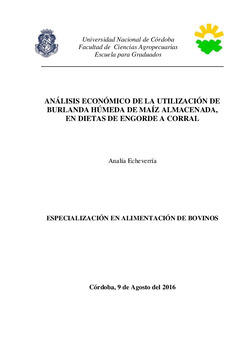| dc.contributor.advisor | De León, Marcelo | |
| dc.contributor.author | Echeverría, Analía | |
| dc.date.accessioned | 2016-10-17T20:02:02Z | |
| dc.date.available | 2016-10-17T20:02:02Z | |
| dc.date.issued | 2016 | |
| dc.identifier.uri | http://hdl.handle.net/11086/4167 | |
| dc.description | Trabajo Final (Especialización en Alimentación de Bovinos)--UNC- Facultad de Ciencias Agropecuarias, 2016. | es |
| dc.description.abstract | El almacenamiento de burlanda húmeda de maíz, ya sea sola o en mezcla con alimentos
fibrosos, es una alternativa para aquellos productores que utilicen este subproducto. Su
implementación requiere de un análisis económico y técnico, que evalúe tanto su
aplicación práctica como su valor nutricional y su efecto en la rentabilidad del sistema. El
objetivo de este trabajo fue realizar un análisis económico de la utilización de burlanda
húmeda de maíz almacenada, en dietas de terminación de novillos de engorde a corral.
Para este análisis se consideró el caso del establecimiento La Reserva, ubicado en la
localidad de Tortugas, Santa Fe. El estudio de costos permitió calcular el precio de la
materia seca de burlanda adquirida en épocas de baja cotización y almacenada con dos
fuentes de fibra, bajo dos estructuras de almacenamiento y evaluar comparativamente con
burlanda húmeda adquirida en épocas de alta cotización. Se formularon dietas isoprotéicas
e isoenergéticas para estimar el aumento de peso producido y su costo. También se
comparó el costo del kilogramo de proteína aportada por este subproducto almacenado con
fibra, respecto a otras fuentes proteicas. Los resultados demostraron que, desde el punto de
vista económico, sería conveniente adquirir la burlanda húmeda en épocas de baja
cotización y almacenarla con fibra, lo que permitiría conservar este subproducto para que
el productor lo tenga disponible en épocas de alta cotización. El precio del kilogramo de
aumento de peso y de proteína es menor con esta alternativa si se la compara con adquirir
burlanda en épocas de alta cotización. El costo del flete de la burlanda húmeda al
establecimiento La Reserva impacta negativamente en el costo del kilogramo de proteína.
Esto hace que frente a otras fuentes proteicas, no convenga utilizar la burlanda húmeda
bajo las condiciones analizadas, debido a su alto porcentaje de humedad. La utilización de
burlanda almacenada con fibra en dietas para bovinos, permitiría mejorar la calidad de esta
última, generando un aumento en el consumo, en la eficiencia de conversión y en la
ganancia media diaria de peso, con respecto al uso de estos alimentos por separado. | es |
| dc.description.abstract | Storing wet distillers grains with solubles alone or mixed with fibrous food is an
alternative for those producers that using this product. Its implementation requires an
economic and technical analysis, to assess the practical application as both nutritional
value and its effect on the profitability of the system. The objective of this work was to
make economic analysis of the use of wet distillers grains with solubles stored in
termination diets feedlot steers. For this analysis considered the case at La Reserve, located
in the town of Tortugas, Santa Fe. The cost study possible to calculate the price of dry
matter wet distillers grains with solubles purchased in times of low price and stored with
two sources of two, under two storage structures and evaluate comparatively with wet
distillers grains with soluble in times of high price. Isoproteic and isocaloric diets were
formulated to estimate weight gain produced and its cost. Also compared the cost of a
kilogram of protein provided by this product stored fiber, compared to other protein
sources. The results showed that, from the economic point of view, it would be convenient
purchase wet distillers grains with solubles in times of low price and store with fiber,
which would allow preserver this product for the producer of having it available in times
of high price. The price of the kilogram of weight gain and protein is lower with this
alternative if comparability with wet distillers grains with solubles purchase during high
price. Cost of wet distillers grains with solubles shipping to the La Reserva establishment
has negative impact on the cost of one kilogram of protein. This makes a front of other
protein sources not appropriate to use the wet distillers grains with solubles under the
conditions tested, due to its high percentage of humidity. The use of wet distillers grains
with solubles stored with fiber in diets for cattle, would improve the quality of the latter,
generating increased in the consumption, in the conversion efficiency and the average daily
gain of weight, with respect to the use of these foods separately. | en |
| dc.format.extent | 53 h. : ilustración color, tablas | es |
| dc.language.iso | spa | es |
| dc.rights | Atribución-NoComercial-SinDerivadas 2.5 Argentina | * |
| dc.rights.uri | http://creativecommons.org/licenses/by-nc-nd/2.5/ar/ | * |
| dc.subject | Alimentación de los animales | es |
| dc.subject | Engorde a corral | es |
| dc.subject | Feedlot | es |
| dc.subject | Zea mays | es |
| dc.subject | Subproductos de la molinería | es |
| dc.subject | Valor nutritivo | es |
| dc.subject | Dieta | es |
| dc.subject | Rentabilidad | es |
| dc.subject | Análisis económico | es |
| dc.subject | Maíz | es |
| dc.title | Análisis económico de la utilización de burlanda húmeda de maíz almacenada, en dietas de engorde a corral | es |
| dc.type | masterThesis | es |





